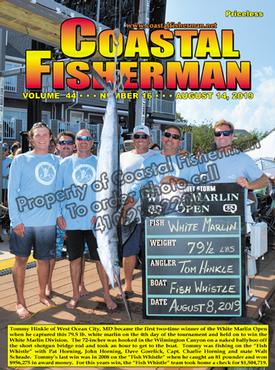


Article by Capt. Steve Katz
 What time is it?
What time is it?
Congratulations to the all participants and winners in this year’s White Marlin Open. The challenge of running offshore for consecutive days in all weather conditions is a lot of work for the crew and catching a prize winning fish is even more difficult. Great job to all.
We also wish all crew and anglers good luck in The MidAtlantic next week.
Let’s review a popular topic during fishing tournaments - Time of day.
While many crew members may not wear a watch while fishing, keeping track of the correct time is even more critical during a tournament. With so many electronic gadgets supplying the time, we expect the time we see to be correct and synchronized between all devices. A marine chartplotter or GPS, as with most modern time keeping devices, needs to be properly programmed to your location for the proper time zone and the use of day light savings time. Many of us have come to rely on the time on the chartplotter or related devices for the proper time.
How does a GPS chartplotter know the correct time?
Chartplotters receive the time from the GPS satellites. In addition to longitude, latitude and altitude, the Global Positioning System (GPS) provides a critical fourth dimension – time. Each GPS satellite contains multiple atomic clocks that contribute very precise time data to the GPS signals. GPS receivers decode these signals to the UTC standard and effectively synchronizing each GPS receiver to the world’s atomic clocks. This enables users to determine the exact time to within 100 billionths of a second, without the cost of owning and operating atomic clocks.
The manufacturers of GPS receivers’ generally automate the device’s time settings, allowing the time to be automatically adjusted based on your GPS location, just like a smart phone.
Seems like a good idea, right? Well many of the devices may be too smart. They know when your boat moves into a different time zone or time of year and even when it has exceeded the coastal 12-mile territorial waters of the USA. Once beyond the 12-mile coastal limit, the chartplotter often automatically eliminates the daylight savings time (subtracting one hour in the summer) on the way to the distant fishing grounds and then adds back the one hour on the return trip to port at that same 12-mile territorial water limit.
The best way to deal with this issue and synchronize the vessels time to the same time zone at port is to manually configure the time zone (or offset) of your GPS display systems. Often, the “Time of Day” menu on the chartplotter has a setting for display format and offset adjustment from UTC. Keeping the same time at sea and at port will also allow your calculated estimated time of arrival to be correct. Here in Maryland during the summer, the time zone is -4 (minus 4 hours) from UTC (Universal Time Coordinated).
Garmin chartplotter devices seem to need a manual time zone configuration more than other brands since they default to the automatic time zone settings for simplicity. The steps below are for the most popular current Garmin devices. Other brands may be similar.
•Start from the Home screen.
•Select Configure/Settings
•Select Preferences
•Select Units
•Select Time
•Select Time Zone
•Select Custom
GMT or UTC?
Many of us once referenced time based on Greenwich Mean Time (GMT). GMT is actually a time zone in England that also happens to be the same as UTC. The Universal Time Coordinated (UTC) is an international standard referenced around the world. UTC is an atomic timescale. It usually has 86,400 seconds per day, but is kept within 0.9 seconds of the mean solar time by the introduction of occasional leap seconds. If you are curious, there are currently 37 worldwide time zones with some zones 30 or 45 minute intervals as compared to the traditional one hour differentials based on 1 hour per 15 degrees longitude.
Captain Steve Katz is the owner of Steve’s Marine Service and holds NMEA, AMEI and NMEA2000 certificates along with ABYC Master Technician certification and factory training from many manufacturers. To reach Steve, call 410-231-3191.